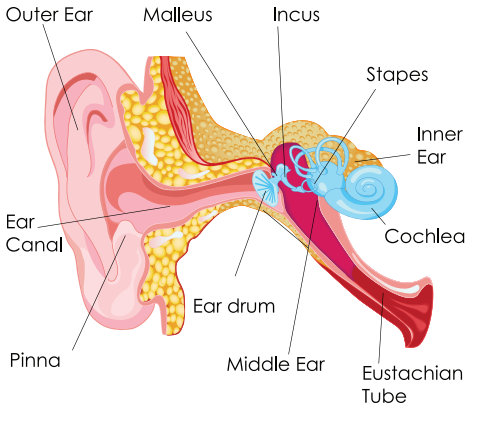 Earache
Earache
Another term for ear pain, which can have many different causes.
Causes
- Ear Infection: An infection of the middle ear (space behind the eardrum) is commonly caused by viruses or bacteria.
- Swimmer’s Ear: An infection or irritation of the skin that lines the ear canal. The main symptom is an itchy ear canal. If the canal is infected, it becomes painful.
- Ear Canal Injury or Abscess: A cotton swab or fingernail can accidentally scrape the ear canal or infection of a hair follicle in the ear canal can appear as a small red bump. Oftentimes the bump turns into a pimple and needs to be drained.
- Earwax: A larger piece of hard earwax can cause mild ear pain, especially if the wax has been pushed in by cotton swabs.
- Foreign Object: If an object is sharp or pushed far into the ear canal, professional removal is needed.
- Airplane Ear: If the Eustachian tube is blocked, sudden increases in air pressure can cause the eardrum to stretch. Often experienced during landing decent or mountain driving.
- Pierced Ear Infections: Common, but often painful if not treated early.
- Referred Pain: Ear pain can also be referred from diseases not located in the ear. For example, tonsil infections, tooth decay in a back molar, and jaw pain (TMJ syndrome).
Hearing Loss
Often gradual due to aging and chronic exposure to loud noises, but can be sudden as well.
Causes
- Damage to the Inner Ear: Aging and exposure to loud noise may cause wear and tear on the hairs or nerve cells in the cochlea. When these are damaged or missing, electrical signals are not transmitted efficiently, and hearing loss occurs.
- Gradual Buildup of Earwax: Earwax can block the ear canal and prevent conduction of sound waves.
- Ear Infection & Abnormal Bone Growths or Tumors: In the outer or middle ear, any of these can cause hearing loss.
- Ruptured Eardrum (Tympanic Membrane Perforation): Loud blasts of noise, sudden changes in pressure, poking your eardrum with an object, and infection can cause the eardrum to rupture and affect hearing.
The only way to find out the cause of your ear pain or hearing loss is to see a medical professional. Oftentimes, an ear, nose and throat (ENT) physician is needed to fully resolve the issue.
Otology is a branch of medicine which studies the normal and pathological anatomy and physiology of the ear (including hearing and vestibular sensory systems, and related structures and functions) as well as their diseases, diagnoses, and treatments.
Eardrum Perforation Repair
A hole in the eardrum can be caused by numerous factors such as infection, trauma, and/or prior surgeries. When present, these holes can cause decreased hearing, frequent ear infections and the inability to get water in the ear. Surgical repair involves creating a new ear drum, which is typically made by using the body’s own tissue to reconstruct it. Repair can lead to a normal functioning ear with improved hearing, resolution of infections, and the ability to participate in water activities.
A hole in the eardrum can be caused by numerous factors such as infection, trauma, and/or prior surgeries. When present, these holes can cause decreased hearing, frequent ear infections and the inability to get water in the ear. Surgical repair involves creating a new ear drum, which is typically made by using the body’s own tissue to reconstruct it. Repair can lead to a normal functioning ear with improved hearing, resolution of infections, and the ability to participate in water activities.

Eardrum perforation. After surgical repair, the patient had complete resolution of their hearing loss and was able to participate in water activities without any issues.
Ear Tumor Removal
Growths within the ear can erode surrounding structures and lead to recurrent infections and hearing loss. The most common type of growth is called a cholesteatoma and is often referred to as a skin cyst of the inner ear. These growths require surgery for definitive removal and to prevent further damage to the ear. Often, hearing can also be improved with this surgery as well.

Ear with chronic drainage and hearing loss due to a cholesteatoma.
Widening of the Ear Canal
Sometimes the ear canal can become narrowed due to scarring or overgrowth of the underlying tissue. This can lead to hearing loss, recurrent infections and difficulty for the ear to self-clean any wax. Surgery can widen the ear canal and restore its normal function.

The ear canal is completely obstructed by a bony lesion called an osteoma. The osteoma caused recurrent wax build up, along with hearing loss.

The eardrum is clearly visualized after surgical removal of the osteoma.

